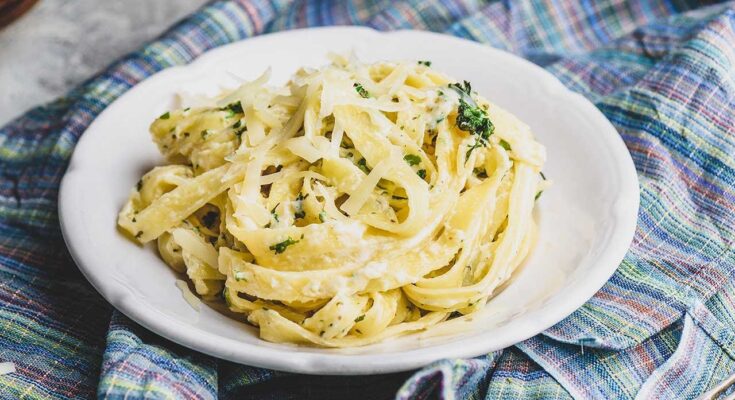Alfredo Sauch Recipe: Alfredo sauce is the kind of kitchen magic that never goes out of style. Believe it or not, this creamy delight actually comes from Rome—not your local Italian restaurant! It was first whipped up by Alfredo di Lelio in the early 1900s. Legend has it, Alfredo was trying to cook something soothing for his wife who had lost her appetite after giving birth. So, he made a rich, buttery pasta dish using just a few ingredients: butter, Parmesan, and pasta water. Little did he know, he was about to change the pasta game forever.
The dish gained international fame when Hollywood stars Mary Pickford and Douglas Fairbanks tasted it while vacationing in Rome. They fell in love with it and brought it back to the States. Over time, Americans added their own twist—hello heavy cream!—and that’s how we got the creamy Alfredo sauce we now know and crave.
Why Everyone Loves Alfredo
There’s a reason Alfredo is a go-to comfort food. It’s rich, cheesy, velvety, and feels like a warm hug in a bowl. Whether you’re using it as a base for fettuccine, drizzling it over chicken, or dunking your breadsticks in it, Alfredo sauce hits the spot. Plus, it’s super quick to make. You don’t need to be a five-star chef to pull this off. With just a handful of ingredients and about 15 minutes, you’ve got yourself a gourmet-level sauce.
It’s also incredibly versatile. Want to toss in some sautéed mushrooms, grilled shrimp, or roasted broccoli? Go for it! Alfredo plays well with others. And unlike tomato-based sauces, it’s rich without being acidic, making it a favorite for people with sensitive stomachs or just those craving something ultra-creamy.
Key Ingredients for Alfredo Sauce
Choosing the Right Butter
Butter is the backbone of Alfredo sauce. It sets the tone for the flavor, so go for the good stuff. Unsalted butter is best because it lets you control the saltiness of the dish. You’ll want it fresh—not the kind that’s been sitting in your fridge since last Thanksgiving.
Look for European-style butter if you can. It’s got a higher fat content and a richer flavor, which makes your Alfredo extra luscious. If all you’ve got is standard supermarket butter, that’s fine too—just make sure it’s unsalted.
Importance of Fresh Garlic
Now, garlic is optional in traditional Alfredo, but let’s be honest—garlic makes everything better. A clove or two finely minced and sautéed in the butter takes your sauce from good to restaurant-quality. Skip the powdered stuff, though. Fresh garlic gives you a depth of flavor that no jar or shaker can compete with.
When sautéing garlic, timing is everything. You want to soften it just enough to release the aroma without burning it. Burnt garlic can make your sauce taste bitter, and no one wants that.
Which Cheese is Best?
Parmesan, hands down. But not just any Parmesan—go for Parmigiano-Reggiano if you really want to flex. It’s nuttier, saltier, and melts beautifully into the sauce. Grate it yourself if you can. Pre-shredded cheese often contains anti-caking agents that prevent it from melting smoothly, and that can ruin the texture of your sauce.
If you want to mix things up, you can blend in a bit of Romano or Asiago, but Parmesan should always be your base. About one cup of freshly grated Parmesan will do the trick for a single batch of sauce.
Kitchen Tools You’ll Need
Essential Cooking Utensils
Before you dive into cooking, make sure you’ve got your tools ready to roll. You don’t need a fancy kitchen setup, just a few basics:
- Medium saucepan – For making the sauce.
- Whisk – To help blend everything smoothly.
- Garlic press or knife – For prepping the garlic.
- Grater – Preferably microplane for fine Parmesan.
- Measuring cups and spoons – Accuracy matters.
These are your ride-or-die kitchen companions when it comes to making Alfredo sauce that’s smooth, creamy, and lump-free.
Optional Tools to Make Life Easier
Want to make your cooking life even smoother? Consider having these optional tools on hand:
- Immersion blender – If you ever need to rescue a clumpy sauce.
- Silicone spatula – Great for scraping every last drop of that saucey goodness.
- Sauce warmer or double boiler – Helps keep the sauce warm without curdling.
These aren’t must-haves, but if you’re serious about your Alfredo game, they can level up your kitchen flow.
Step-by-Step Alfredo Sauce Recipe
Step 1 – Melting the Butter
Start by melting half a cup of unsalted butter in your saucepan over medium heat. Let it fully melt and just begin to bubble. Don’t let it brown—this isn’t a beurre noisette kind of sauce. You’re just trying to create a smooth, rich base.
If you’re using garlic, now’s the time to add it in. Sauté it gently for about 30 seconds until it’s fragrant. Your kitchen should start smelling incredible right about now.
Step 2 – Adding Garlic for Flavor
Garlic is where the magic starts to unfold. If you’ve decided to include it (and we highly recommend you do), make sure it’s minced finely or crushed for maximum flavor infusion. Once your butter is melted and slightly bubbling, toss in the garlic and let it sizzle gently.
The key here is patience. You want to cook the garlic just until it’s golden and aromatic—not brown. Burnt garlic turns bitter fast, and it can throw off the entire balance of your Alfredo sauce. Stir it frequently for 30 to 60 seconds to avoid sticking or burning.
This step adds a savory base that cuts through the richness of the cream and cheese. It’s subtle, but it makes a world of difference. Garlic doesn’t just enhance flavor; it gives the sauce a deeper, almost earthy backbone that makes people go, “Whoa, what’s your secret?”
If you’re not a huge garlic fan, you can also try infusing the butter with garlic by cooking whole crushed cloves in the butter and removing them before adding the cream. That way, you get the flavor without the chunks.
Step 3 – Pouring in the Cream
Next up: the cream. This is where the Alfredo gets its signature silky-smooth texture. Slowly pour in 1 cup of heavy cream (also known as heavy whipping cream) into your buttery, garlicky mixture. Stir continuously as you pour to combine everything seamlessly.
Turn the heat down to low-medium and let the cream gently simmer—not boil—for about 5 to 7 minutes. Stir often to avoid scorching. As it heats, the cream thickens slightly and melds with the butter to create that luxurious base we all love.
Now, if you’re wondering whether you can use milk instead of heavy cream—technically, yes, but it won’t be the same. Heavy cream gives Alfredo its body and richness. Milk or half-and-half just won’t cut it unless you’re going for a lighter (but less creamy) version. If you’re watching calories, consider using evaporated milk as a compromise—it still gives a creamy texture but with less fat.
Pro tip: At this stage, a pinch of nutmeg can do wonders. It’s not traditional, but just a dash gives the sauce a slightly sweet warmth that elevates the flavor without overpowering it.
Step 4 – Stirring in the Parmesan
Now it’s time for the best part—cheese! Gradually add in 1 to 1¼ cups of freshly grated Parmesan cheese while stirring constantly. Don’t dump it all in at once or you’ll risk clumps. Go slow, and keep whisking until each handful melts before adding more.
As the cheese melts, your sauce will start to thicken into that dreamy Alfredo texture. Keep your heat low and steady—you don’t want to scorch the dairy or break the sauce. If it gets too thick, just add a splash of milk or pasta water to loosen it up.
This is where the magic happens: the emulsification of butter, cream, and cheese. You’re creating a velvety, glossy sauce that clings to every strand of pasta like it was born to be there. And let’s be honest, that’s the goal.
Make sure the cheese is fully incorporated before moving on. No one wants a sauce that separates or feels gritty. Take your time with this step and enjoy the aroma—it’s worth every second.
Step 5 – Final Seasoning Touches
You’re almost there! The last step is seasoning. Taste your sauce first—remember, Parmesan is salty on its own, so you might not need much salt. Start with a pinch of salt and a generous grind of black pepper. Stir, taste again, and adjust as needed.
Some folks like to toss in a little Italian seasoning, a pinch of white pepper, or even a touch of chili flakes for a subtle kick. Feel free to make it your own, but don’t overdo it—Alfredo sauce is meant to let the cream and cheese shine.
This is also the time to check your sauce’s consistency. Too thick? Add a bit of warm milk or pasta water. Too thin? Let it simmer for another couple of minutes, but don’t forget to stir frequently.
Once you’re happy with the flavor and texture, take the sauce off the heat. If you’re not serving it immediately, keep it warm on the lowest heat setting and stir occasionally to keep it smooth.
Congratulations—you just made homemade Alfredo sauce like a pro!
Tips for the Perfect Alfredo Sauce
Common Mistakes to Avoid
Even though Alfredo sauce is simple at its core, there are a few pitfalls that can turn your creamy dream into a kitchen nightmare. First up—don’t let the cream boil. It’s tempting to crank the heat to speed things up, but that’ll only cause the cream to separate or curdle. Low and slow is the name of the game.
Next, don’t use pre-shredded cheese. It might save you a few minutes, but those anti-caking agents in pre-packaged cheese can prevent it from melting smoothly, leading to a gritty texture. Freshly grated is always better—your taste buds will thank you.
Another mistake? Adding cold cheese into hot cream. Big no-no. That temperature difference can shock the sauce and create lumps. Instead, let your cheese sit at room temp for a few minutes before adding it to the pot.
Over-seasoning is another common error. Parmesan brings a lot of salt to the table already, so always taste before adding more salt. And finally, rushing the sauce—give it time to thicken naturally. Trust the process.
Pro Tips from Home Chefs
Want to make your Alfredo truly unforgettable? Here are a few insider tips from passionate home cooks:
- Use pasta water: If your sauce needs thinning, save some starchy pasta water. It not only loosens the sauce but helps it cling to the pasta better.
- Add a yolk: For an extra-rich twist, stir in one egg yolk right at the end. It adds silkiness and depth.
- White pepper vs. black: White pepper blends more subtly into the sauce, offering heat without little black specks.
- Infuse your cream: Simmer the cream with herbs like thyme or a bay leaf (then remove before serving) for added aroma.
These tweaks aren’t necessary for a traditional Alfredo, but if you’re feeling adventurous or want to impress someone special, they can take your sauce to the next level.
Best Dishes to Pair with Alfredo Sauce
Classic Fettuccine Alfredo
The most iconic pairing—fettuccine Alfredo—is what made this sauce famous worldwide. The flat, wide noodles are the perfect vehicle for thick, creamy sauce. When done right, each ribbon of pasta gets coated evenly, delivering a perfect bite every time.
To prepare, simply boil your fettuccine until al dente, then toss it directly in the pan with your Alfredo sauce. Add a splash of pasta water to marry everything together. Let it simmer for a minute or two while you stir gently.
Garnish with fresh chopped parsley, cracked black pepper, and extra Parmesan. Want to get a little fancy? Top with grilled chicken, shrimp, or even crispy pancetta for an extra pop of protein and texture.
Fettuccine Alfredo is the ultimate comfort food, ideal for date nights, dinner parties, or lazy Sunday dinners. It’s simple but elegant—and guaranteed to impress.
Chicken and Broccoli Alfredo
If you’re looking to make your Alfredo sauce a little more hearty and balanced, throw in some chicken and broccoli. The savory, juicy chicken pairs beautifully with the creamy sauce, while the broccoli adds freshness and crunch.
Start by pan-searing sliced chicken breasts seasoned with salt, pepper, and garlic powder until golden and cooked through. Steam or blanch the broccoli until just tender—still bright green and slightly crisp.
Once your Alfredo sauce is ready, combine everything in one big skillet or pot: the cooked fettuccine, chicken, broccoli, and a little pasta water. Toss it all together to coat evenly.
This combo not only adds color and nutrition but also creates a full meal in one pan. It’s great for feeding a hungry family or meal-prepping for the week. Leftovers (if there are any) reheat beautifully and taste just as amazing the next day.
Storing and Reheating Alfredo Sauce
How Long Will It Last?
Alfredo sauce is best enjoyed fresh, but if you’ve got leftovers, don’t worry—it can be stored safely for later. Let the sauce cool to room temperature first (don’t just throw hot sauce into the fridge). Then transfer it into an airtight container.
Stored properly in the refrigerator, Alfredo sauce will stay fresh for up to 4 days. Beyond that, the dairy can start to spoil or separate, which affects both taste and texture.
Freezing? Yes, it’s possible, but there’s a catch. Cream sauces like Alfredo can separate when thawed. If you do freeze it, use a freezer-safe container and plan to whisk it vigorously during reheating. It won’t be exactly the same, but it’ll still be delicious.
Pro tip: Label your containers with the date so you always know how long it’s been sitting in the fridge or freezer.
The Right Way to Reheat Without Splitting
Reheating Alfredo sauce can be tricky—it’s not as simple as popping it in the microwave. If you’re not careful, the sauce can separate or turn oily. To keep it smooth and creamy, use one of these gentle methods:
- Stovetop: Place the sauce in a saucepan over low heat. Add a splash of milk or cream and whisk constantly until the sauce is warm and smooth again.
- Microwave: If you must use the microwave, go low and slow. Use 50% power, heat in 30-second intervals, and stir in between.
Avoid overheating or letting it boil. The gentle heat helps the fats stay emulsified and prevents the cheese from turning grainy. If the sauce looks like it’s splitting, try adding a tablespoon of warm cream and whisk vigorously to bring it back together.
Want to revive day-old Alfredo pasta? Add a little cream or milk before reheating. It’ll bring back the luscious texture and keep your pasta from drying out.
FAQs about Alfredo Sauce Recipe
Q1: What is Alfredo sauce made of?
Alfredo sauce is traditionally made with butter, heavy cream, and grated Parmesan cheese. Some recipes may include garlic, salt, and pepper for extra flavor.
Q2: Can I make Alfredo sauce without heavy cream?
Yes, you can substitute heavy cream with whole milk and a bit of flour or cornstarch for thickness. Greek yogurt or cream cheese are also common alternatives.
Q3: How do I prevent Alfredo sauce from curdling?
To prevent curdling, cook on low heat and avoid boiling the sauce. Stir constantly and add the cheese slowly after the cream has warmed up.
Q4: Is Alfredo sauce gluten-free?
Traditional Alfredo sauce is gluten-free if thickened with only cream and cheese. However, if flour is used as a thickener, ensure it’s gluten-free flour.
Q5: Can I store and reheat Alfredo sauce?
Yes, store Alfredo sauce in an airtight container in the fridge for up to 3 days. Reheat gently on the stove over low heat while stirring to maintain a smooth texture.
Q6: What can I add to Alfredo sauce for more flavor?
You can add garlic, Italian seasoning, nutmeg, sautéed mushrooms, or cooked chicken or shrimp to enhance flavor and make it more filling.
Q7: Can I freeze Alfredo sauce?
Freezing is possible, but the texture may change when thawed. For best results, stir well while reheating to restore creaminess.
Conclusion
Remember, the secret to a great Alfredo isn’t in fancy techniques or obscure ingredients—it’s in the little details. Use fresh, high-quality components. Keep your heat low and your whisking steady. Be patient. Trust your taste buds. And don’t forget that tiny splash of pasta water—it makes everything come together perfectly.
Alfredo sauce is like that cozy sweater you never want to take off—it’s comforting, dependable, and always there when you need a quick, satisfying meal. So go ahead, get your saucepan ready, and give this recipe a try. Once you taste your own homemade Alfredo, you’ll never go back to store-bought again.
Buon appetito!



